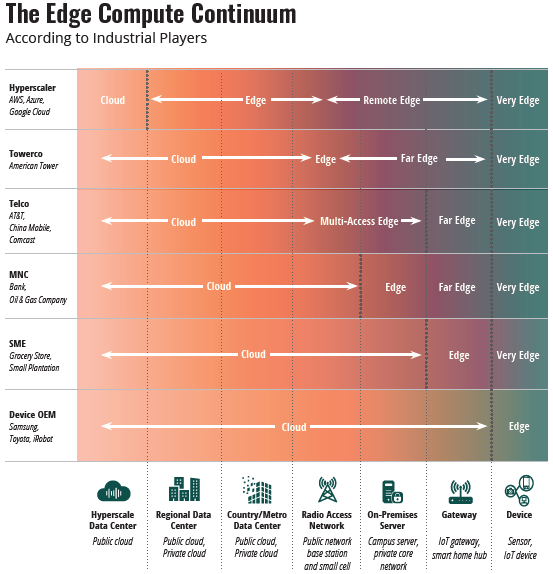 Multi-access edge computing (MEC) is the telco-centric approach to delivering edge computing by integrating it with fixed and mobile access networks. MEC is often used interchangeably to mean edge computing. But is this appropriate? And how does MEC relate to edge computing?
Multi-access edge computing (MEC) is the telco-centric approach to delivering edge computing by integrating it with fixed and mobile access networks. MEC is often used interchangeably to mean edge computing. But is this appropriate? And how does MEC relate to edge computing?
Multi-access edge computing (MEC) is often used interchangeably to mean edge computing. But is this appropriate? What is MEC and how does it relate with edge computing? MEC is the telco-centric approach to edge computing that integrates it with fixed and mobile access networks.
Setting the context
Every few decades, the computing world likes to swing back and forth between centralized and decentralized architectures. While the differences are waning, there is still much discussion around whether the data center—today’s unit of computing—should be located at the edge for edge computing or in the cloud for AI applications (Figure 1).

The choice to decentralize and locate the datacenter at the edge is growing in importance today because it allows the capture and processing of data as close to the source of the data as possible. Just like donuts, it promises that the closer the box is to the consumer, the happier everyone is. Send data to an AI application running in the cloud, and it delays answers. Process that data on an edge device, and it’s like grabbing directly from that pink box of glazed donuts.
Edge computing is big business. IDC expects overall worldwide spending on edge computing (including all hardware, software, services around edge computing) to reach $251 billion by 2025 (IDC Webinar, Future of Operations – Edge and IoT, July 2021). All this spending should stimulate a massive ecosystem. When AI applications are deployed over 5G and edge computing, this ecosystem could be worth in excess of $10 trillion, according to NVIDIA estimates.
Challenge to scale edge computing
Most implementations of edge computing today are standalone, as any user can define, design, and deploy their own bespoke edge computing network. While these implementations deliver benefits to users, the possibility of exchanging data across different edge computing networks or porting applications from one edge network to the other remains a challenge to scaling.
Imagine a hypothetical scenario where each of the 8+ million cellular base stations from over 750 mobile operators is an edge computing node. How do you write code that can work across these gargantuan configurations? Given that most mobile operators control
In comparison, in cloud computing, most developers have only a few options of supersized providers for whom to write code. Each of these hyperscale cloud providers in turn is well positioned to serve 100% of the global market, competition permitting.
In general, for most successful IT/tech innovations, scale comes from either standardization and interoperability, such as the internet or 4G/5G; market leadership from a few pace-setting companies, such as cloud computing or mobile OS; or a combination of both. Crucially, edge computing has not fully developed either.
MEC brings some standardization to edge computing
The early days of edge computing coincided with the early phase of 4G in the early 2010s. For the first time in history, the opportunity to have a fast and reliable internet service anywhere and at any time was becoming a reality.
This association, even though it was coincidental and not preplanned, made the edge of the cellular network the assumed default location for edge computing and the cellular network providers were the gatekeepers. Accordingly, several companies in the telecommunications sector came together in 2014, under the auspices of the European Telecommunications Standards Institute (ETSI, to found the MEC industry initiative.
The goal was for MEC to become the standard for edge computing under certain conditions:
- It is located near a mobile access network.
- It is integrated in some ways to the mobile network.
- It is reachable or usable by third parties, through APIs.
This informed the vision, as outlined in their September 2014 whitepaper, Mobile Edge Computing (original term) to develop favorable market conditions. This would enable IT and cloud-computing capabilities within the radio access network (RAN) in proximity to mobile subscribers. According to the paper, “…the RAN edge offers a service environment with ultralow latency and high-bandwidth as well as direct access to real-time radio network information (such as subscriber location, cell load, etc.) that can be used by applications and services to offer context-related services.”
ETSI’s MEC Industry Standard Group (ISG) task is “…to create a standardized, open environment, which will allow the efficient and seamless integration of applications from vendors, service providers, and third-parties across multi-vendor, multi-access edge computing platforms.” The full list of their related specifications and publications can be found in the MEC Committee page.
From mobile to multi-access
As it soon became evident that edge computing was not restricted to only the cellular network edge, ETSI swapped the name in 2017 from mobile edge computing to multi-access edge computing. But the cellular-centric standardization of edge computing remains, with ETSI MEC, 3GPP SA6 and SA2, and GSMA’s Operator Platform Group all working towards standards and market initiatives for edge computing. For more information, see the Harmonizing standards for edge computing – A synergized architecture leveraging ETSI ISG MEC and 3GPP specifications whitepaper.

Source: Over The Edge: The Opportunities And Challenges Of The Coming edge computing Era,
ABI Research
While this telco-centric view is unlikely to change, other stakeholders often view edge computing differently (Figure 2). There are other bodies who are working to incubate a non-telco-centric vision of edge computing. The Linux Foundation’s LF Edge, the Industrial Internet Consortium, Open Compute Project, and the Open19 edge datacenter project are a few examples.
Ultimately, regardless of whether edge computing is cellular-centric or scaling, its benefits in the age of AI remain an attractive draw for all stakeholders.
